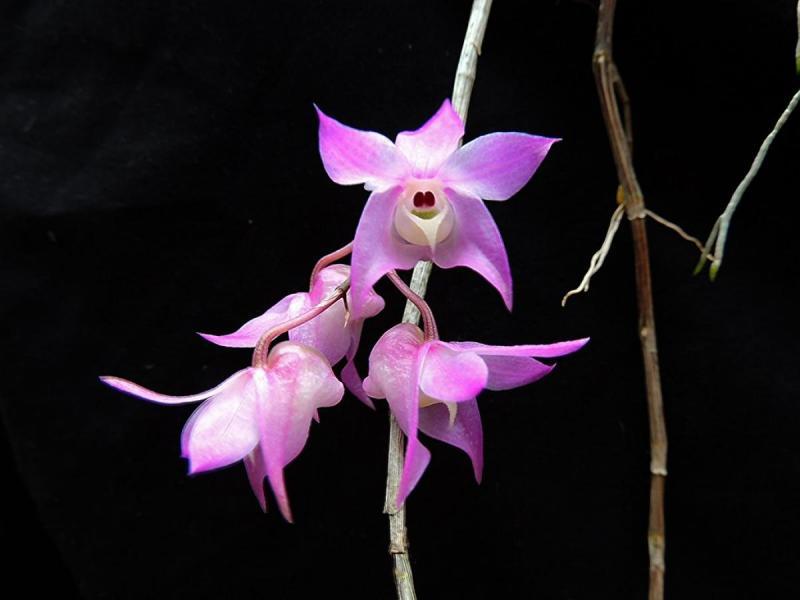Dendrobium aduncum
Also known as: The Inward or Callista adunca Dendrobium aduncum var. faulhaberianum Dendrobium oxyanthum Dendrobium faulhaberianum in the subfamily: Epidendroideae
Native to: Bhutan China Hong Kong Meghalaya - India Nepal Sikkim - India Thailand West Bengal - India
General Information
The Inward is a small to medium sized sympodial cool to warm growing epiphytic orchid belonging to the sub family Epidendroideae native to Bhutan, China, Hong Kong, India, Nepal, and Thailand. The name refers to the wings at the colum apex.
Plant Description
Sympodial. Grows to 30-60cm. Each new growth has numerous elliptic lance shaped leaves that grow to 5-9cm long. Pseudobulbs grow to 30-60cm. The plant forms pendant or arching growths
Flowers
Numerous long lasting, fragrant blossoms appear
Fragrance
The orchid is fragrant.
Substrate(s)
- Coarse
- Medium
- Fine
- Bark
Care Notes
This orchid goes into a dormancy phase during winter, during this phase it is best not to provide water unless the plant is starting to look thirsty. The lack of water increases the chance of flowering in spring, and also reduces the likelihood of any rot forming. Do not resume watering until new growth has appeared and is growing strongly.
Often a period of intense growth occurs after dormancy. During this time the amount of light, water and fertiliser the plant receives will directly impact the amount of growth that occurs during this time, and in the case of seedlings, will reduce the time required to reach maturity.
It's recommended to heavily reduce the water amount at the middle to end of autumn to trigger dormancy. Leaves on older bulbs will begin to drop during this time while the newer bulbs continue to mature until terminal leaves appear at the tip of the pseudobulbs.
Repotting can be done any time of the year though it's best to do it in early spring when new growth is appearing as this also means new roots will appear to help the plant anchor into the new media and offset any damage to established roots during the repotting process.
Fragrant:
- IsFragrant
Climate
Grows at low to high elevations. Rainfall ranges from 5mm to 818mm per day, heaviest in July and lightest in December. Humidity ranges from 57% to 86%, highest in July and lowest in March. Temperature ranges from 7C to 29C, highest in April (22C to 29C) and lowest in January (7C to 21C).
Watering
These orchids are sensitive to excessive watering and should only be watered when they look thirsty. Water infrequently and ensure that the roots are dry before watering. Keep an eye on them especially during hot weather as overwatering can lead to rot, whereas underwatering may result in wilting or shriveling, which while unattractive, will not kill the plant.
Fertiliser
dormant-medium-demand-orchid Apply fertiliser regularly at half strength year round. Use a high Nitrogen fertiliser during Spring and Summer. Use a high Phosphorous fertiliser during Summer.
Potting
It's best to observe the root system when repotting and use that as a guide:
A plant with a short root system will do better in a shallower pot with a fine mix, or mounted on fern or cork supplanted with a good amount of moss or similar material.
A plant with a long root system often does well in a pot filled with moss or fine media, mixing in perlite and charcoal is always beneficial to reduce the likelihood of the mix becoming soggy and keeps it fresh.
A plant with a coarser long root system can be potted in a deeper pot, but with 2/3 coarse material such as bark, expanded clay, or coco chips and topped with moss or similar material. This will allow the moisture to remain inside the pot but give the roots air as well.
This plant does well mounted.



